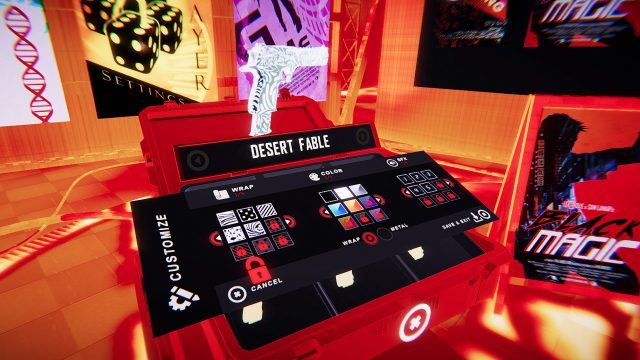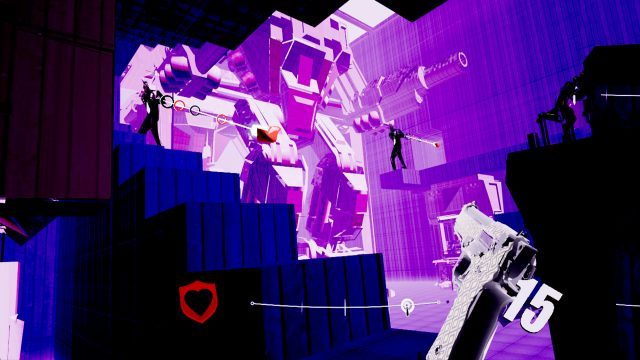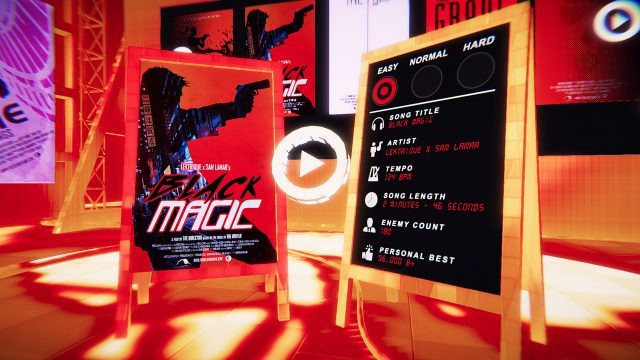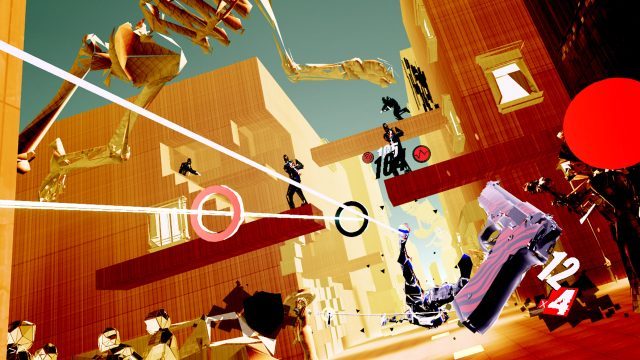
Formerly known for its linear, story-driven VR adventure series The Gallery, Pistol Whip is a surprising shift for Cloudhead Games into VR’s rhythm and shooting genres. Surprising as it may be, the studio makes a strong case for fusing the two, with a ‘rhythm shooter’ that engages your body in a very unique and compelling way.
Pistol Whip Details:
Developer: Cloudhead Games
Available On: Oculus (Rift, Quest), Steam (Index, Vive, Rift, WMR), Viveport (Vive, Index, Rift, WMR)
Reviewed On: Index, Quest
Release Date: November 7th, 2019
Price: $25
Gameplay
Pistol Whip is a creative and generally successful fusion of rhythm and shooting. The game has you constantly moving forward through a ‘level’ (set to a specific song) where enemies appear and shoot at you. Your job is to not only return fire, but dodge incoming bullets. The game has heavy auto-aim by default (which you can disable for a challenge), which allows you to focus less on laser-precise aiming, and more on finding the flow state where dodging and shooting becoming one.
Enemy bullets fly at you slowly enough to give you time to dodge your head out of the way as they approach. As you get used to the timing, you start to proactively move and dodge rather than simply react. As a result you start to ‘flow’ your upper body around as you dodge and shoot your way through each level. The movement feels a lot like being an Agent from The Matrix (1999):
Though the game doesn’t explicitly say this (oddly), you’ll get more points for firing on time with the beat. The game is at its best when you start to find the perfect combination of movements to stay clear of bullets while taking down baddies to beat of the song.
This ‘flowy’ movement can be really engaging, especially considering the health system. You have armor which can take one bullet, but if you take one more hit, then you die and fail the level. That is to say that you have a strong incentive to be aware of incoming bullets and ensure that you dodge them. Luckily, after your armor breaks, you can restore it by shooting a certain number of enemies, or by going for a risky melee kill. The tension of the game is seriously amped up when your armor is down and you’re just desperately hoping to get it back before catching a stray bullet.
All enemies function effectively the same, though there’s one-shot, two-shot, and four-shot variants, which you can identify based on what their armor looks like. As their armor increases, so does their threat, and you’ll find yourself wanting to prioritize the armored enemies for a swift kill or a melee takedown.
Speaking of stray bullets—Pistol Whip’s least obvious but actually quite significant contribution to VR game design is its ‘off-screen’ indicator system that alerts you to enemies and bullets outside of your field of view. This is common (and incredibly useful) in non-VR games, and while it’s been attempted in VR elsewhere, the system in Pistol Whip is incredibly effective at drawing your attention where it needs to be.
That said, the game still has moments of frustration where it feels like you died in an unfair way, either from a bullet you couldn’t make out against all the action and visual noise, or from enemies spawning within feet of you and shooting before you can react.
Unfortunately, killing enemies will a melee attack—the game’s very namesake—is its most awkward interaction. Although the sound and motion of smashing an enemy is very satisfying, the approach always manages to feel awkward because you’re subjecting yourself to point-blank fire. Without a good feeling for when enemies are about it shoot, you wind up doing a rather awkward dance in the hopes of making it close enough to hit the enemy with your gun. Fortunately, melee is optional, and you can always shoot enemies in front of you, even if it won’t get you as many points or restore your armor right away.
While Pistol Whip’s fundamentals are really strong, and the game sometimes lets you enter a very unique flow state which combines dodging and shooting to the beat, it feels like the ‘maps’ (the positions and timing of each enemy) are not yet honed enough for the game to reach its ultimate potential. There are some particularly fun moments in some levels which are akin to ‘patterns’ in other rhythm games; combinations of enemy positions and timing which make for intuitive, fun, and repeatable movements. But generally speaking, those moments feel few and far between.
It’s an outright shame that the game is launching without a level editor, and a lesson that should had been resoundingly clear after Beat Saber; allowing the population of a game to effectively crowdsource new and fun patterns and maps is a win-win for developers and players. Cloudhead says they have plans for some sort of editor in the future, but this should have been a day one feature.
That leaves the game launching with just 10 songs—though I was glad to see a surprising range of gameplay and feeling between songs (for instance, some have you shooting at a distance in wide open spaces while others have you in claustrophobic hallways). More levels, both free and paid, are planned for the future, and hopefully we’ll see a post-launch evolution in level mapping that will make the game feel like it’s truly reaching its potential.

While a level editor may not be available, a generous set of options allows you to tweak elements of the game to taste. In addition to being able to customize the look, sound, and color of your weapon, a ‘Modifiers’ menu allows you to change the game in some fundamental ways. The first one I would suggest looking at is the ‘Dual Wield’ mode; I’ve found that having two guns better facilitates the fun ‘flow’ moments of the game, and brings more engaging moments of beat matching.
You can also enable Unlimited Ammo (no reloading), No Ammo (dodging and melee only), Deadeye (no auto-aim… good luck!), Hardcore (on-hit death), and No Fail.
But wait, there’s more! Pistol Whip also allows you to adjust things like the strength of different haptic effects, the pitch of your gun, and even the trigger threshold to define when, exactly, your gun should shoot as you pull the trigger.
Pistol Whip on Quest
In our testing of Pistol Whip on Quest, we found no significant differences in gameplay compared to the PC version. The song selection, customization options, and settings are the same, and the game runs smoothly. Quest’s built-in audio also handles the songs well enough that it doesn’t feel essential to use external headphones, though if you’re really looking to get into the zone you might prefer them.
Immersion

While Pistol Whip doesn’t have that sensation of a ‘concrete’ world around you (owed to the continuous movement), it does create a very compelling feeling of ’embodiment’ thanks to the threat of bullets constantly encroaching into your personal space. Dodging bullets requires understanding their position and trajectory, and then moving yourself accordingly. Combined with the need to also coordinate your own counterattacks with dodging, the feeling of ‘flow’ is at times very real and engaging.
The pulsating environment and impressionistic look can sometimes feel like excess visual noise which can make it harder to spot bullets. This is also annoying when you’re trying to dodge your head around pillars and suddenly they expand/pulsate (the whole of the environment does this at times), making it harder to visualize the hitbox that you’re trying to avoid.

While the game’s song selection and settings menus are perfectly functional, they aren’t particularly intuitive out of the gate. While the effort to spatialize the interface is appreciated, the hierarchy, organization, and design language needs a more thoughtful approach. Luckily, once you know what you’re looking for, the menus don’t have any impact on the core gameplay.
Comfort

Although you’re constantly moving forward, I’ve found Pistol Whip to be perfectly comfortable when it comes to virtual movement. Even in tight corridors (where the near-field geometry in your periphery would be more likely to trigger vection), I’ve never felt an ounce of motion sickness from in the game even after more than an hour of continuous play.
Pistol Whip is a physical game, especially when played at higher difficulties. Everyone has their own style, but my particular way of playing made significant use of my thighs and knees more so than my arms. At times when playing I would often find myself nearly squatting and learning all the way to the ground (and at least once or twice actually going down on one knee to dodge). It’s very cool that the game is compelling enough to encourage these motions, though if you have especially bad knees or limited physical mobility, Pistol Whip might not be for you.
Though you can make adjustments to your playspace positioning in the game’s settings, the game would be difficult to play seated because of the range or motion required.
The post ‘Pistol Whip’ Review – Shooting for the Flow State appeared first on Road to VR.
Ream more: https://www.roadtovr.com/pistol-whip-review-oculus-quest-steam-pc/
No comments:
Post a Comment